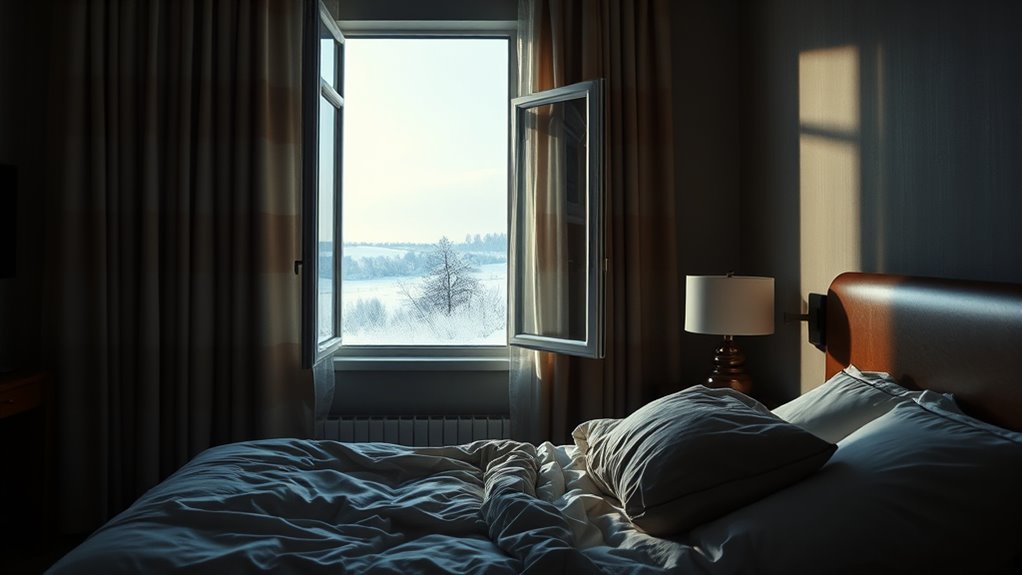Sudden temperature drops in upper-floor hotel rooms often result from HVAC malfunctions, such as thermostat issues or blocked vents, combined with poor insulation and drafts. These problems can cause quick heat loss and cold spots, making your stay uncomfortable. Fixing the HVAC system or improving insulation usually resolves the issue. To understand how these factors interact and what steps you can take, keep exploring the details behind these common causes.
Key Takeaways
- HVAC malfunctions, such as thermostat issues or blocked vents, often cause sudden temperature drops in upper-floor hotel rooms.
- Insufficient or poorly sealed insulation on upper floors allows cold air infiltration, leading to rapid cooling.
- Drafts through gaps, cracks, or poorly sealed windows exacerbate temperature instability in hotel rooms.
- HVAC system failures or cycling issues can result in unintentional cooling or inconsistent heating.
- Prompt inspection and repair of HVAC systems and insulation are essential to restore stable room temperatures.

If you’ve ever experienced a sudden temperature drop in a hotel room, you know how disruptive it can be to your comfort and sleep. On an upper floor, these fluctuations are often more noticeable and frustrating. When the room suddenly feels chilly, it’s easy to assume the thermostat is malfunctioning, but the root causes can be more complex, involving HVAC malfunctions or insulation issues. Understanding these problems can help you identify and perhaps even address the cause during your stay.
HVAC malfunctions are a common culprit behind unexpected temperature drops. Your heating, ventilation, and air conditioning system relies on proper functioning to maintain a steady climate. If there’s a breakdown—perhaps a malfunctioning thermostat, a failing compressor, or blocked vents—the system may fail to deliver consistent warmth. Sometimes, the HVAC unit might turn off unexpectedly or struggle to cycle on, leaving the room colder than intended. If you notice this happening repeatedly, it’s likely an issue with the system’s components. In some cases, the hotel’s maintenance team might be unaware of the problem, so reporting it promptly can lead to quicker resolution.
HVAC malfunctions like thermostat issues or blocked vents often cause sudden temperature drops in hotel rooms.
Aside from HVAC malfunctions, insulation issues are another significant factor. Upper floors often have less effective insulation, which can lead to rapid temperature fluctuations. Poor insulation allows outside cold air to seep in through gaps, drafts, or poorly sealed windows and doors. If the walls and windows aren’t well insulated, the heat generated by the HVAC system quickly dissipates, leading to sudden drops in temperature. Sometimes, even minor gaps or cracks around window frames or electrical outlets can cause drafts that make the room feel much colder. Insulation problems are especially common in older buildings or during extreme weather conditions, where the building’s design doesn’t effectively retain heat. Proper insulation can significantly reduce these fluctuations and improve overall comfort.
Both HVAC malfunctions and insulation issues can work together to create a chilly, uncomfortable environment. If you experience persistent cold spots or sudden drops in temperature, it’s worth checking for these causes. You can try adjusting the thermostat or blocking drafts temporarily, but ultimately, notifying the hotel staff is essential. Professional repairs or insulation improvements are necessary to restore a stable, comfortable climate. Being aware of these potential issues not only helps you advocate for better service but also prepares you to understand why your room’s temperature isn’t behaving as expected. Recognizing these underlying problems can make your stay more comfortable and prevent further disruptions caused by temperature fluctuations.
Frequently Asked Questions
Could External Weather Changes Cause the Temperature Drops?
Yes, external weather changes can cause temperature drops in your hotel room. Exterior influences like cold fronts or wind chill can impact the building’s climate adaptation, especially on upper floors where insulation may be less effective. Sudden weather shifts can lead to noticeable temperature drops, so it’s important to check for drafts or insulation issues and adjust your room’s climate controls accordingly for comfort.
Are There Specific Building Materials That Affect Temperature Fluctuations?
Building materials with poor insulation properties can substantially affect temperature fluctuations in your hotel room. Materials like brick or concrete tend to retain heat, leading to temperature drops when outside air cools. Conversely, well-insulated materials, such as foam or fiberglass, help maintain consistent temperatures by reducing heat transfer. To prevent sudden temperature changes, make certain your room uses high-quality insulation and properly sealed building materials for better temperature regulation.
How Often Do Such Temperature Issues Occur in Similar Hotels?
Think of hotel temperature issues like a well-orchestrated symphony—rarely out of tune, but sometimes there are unexpected pauses. In hotels with similar setups, these problems happen occasionally, maybe a few times per year. They impact guest comfort and HVAC efficiency, causing discomfort and increased energy use. Regular maintenance and system checks can reduce these occurrences, ensuring a smoother experience for guests and more efficient operations.
What Are the Long-Term Impacts of Temperature Fluctuations on Hotel Infrastructure?
You might notice that long-term temperature fluctuations can reduce HVAC efficiency and strain your insulation, leading to higher energy costs and potential damage. Over time, inconsistent temperatures cause wear on systems and degrade insulation quality, which worsens insulation performance and further impacts HVAC efficiency. This cycle can result in costly repairs, decreased comfort, and increased operational expenses, emphasizing the importance of maintaining stable temperatures to protect your hotel’s infrastructure.
Are There Recommended Maintenance Procedures to Prevent These Drops?
Imagine your hotel as a well-oiled machine; to keep it humming smoothly, you should regularly perform HVAC maintenance and insulation checks. These procedures help prevent sudden temperature drops by identifying leaks, faulty thermostats, or duct issues early. Schedule routine inspections, clean filters, and ensure insulation remains intact. Proactive upkeep maintains guest comfort and extends your infrastructure’s lifespan, turning potential cold spots into cozy retreats.
Conclusion
Next time you find yourself shivering in that luxurious hotel room, remember, it’s not just the weather—it’s the hotel’s mysterious attempt at indoor winter sports. Who needs a ski resort when your upper-floor room turns into an unintentional ice palace? So, enjoy the surprise cold snap; after all, nothing beats sleeping in a frosty hotel suite where the thermostat is just a distant, teasing dream. Stay cozy—or at least try to.









